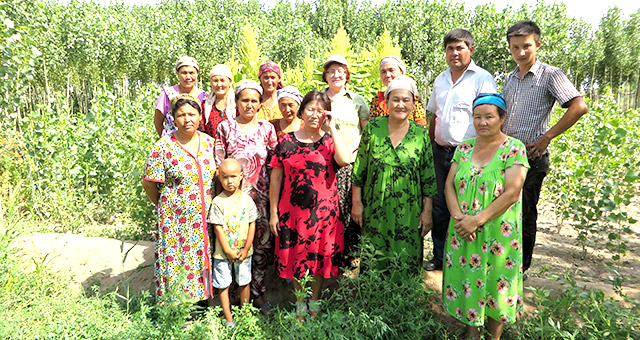
Being predominantly an agro-pastoral agricultural system, the area around the Aral Sea is affected by a very high degree of land degradation, characterized by intensive soil salinity, rising of water table and increasing mineralization, declining of rangeland productivity, as well as biodiversity loss. The most vulnerable are borderline territories, where the situation is even worse because of increasing load of both natural and anthropogenic factors as a result of intensive irrigated agriculture from the one side and degraded overgrazed pastures from the other. Lack of good quality forage for winter, low grazing capacity of desert pastures and remote markets to engage in trade activities, negatively affect the incomes of local people. These conditions deteriorate the livelihoods of the people and induce out-migration, leading to loss of local traditional knowledge and experience of land and water use.
In order to alleviate these problems, within the framework of CGIAR Research Program on Integrated agricultural production systems for the poor and vulnerable in dry areas (CRP Dryland Systems), ICARDA and ICBA engaged in a research activity "Increasing livestock productivity by increasing winter feed production from arable land and hayfields" in 2015. Several demonstration trials were established in shirkat (cooperative farm) “Koybak” and dehkan farms in Karabuga - both sites located in Karauzyak district in Karakalpakstan, Uzbekistan. These sites are the most representative of the agro-pastoral systems of the much larger Amu Darya River watershed in the transition zone between irrigated agriculture and Kyzylkum sandy desert, with a population of at least 1.6 million people living mostly in remote rural areas.
The research activity aimed at studying effective management of marginal (low quality) land and water, production of non-conventional crops (NCC) as forage for livestock and other alternative use. It was found that in such extreme conditions of high soil salinity and water-logging, there are many salt loving species (halophytes) and salt tolerant non-traditional crops to produce good quality forage and grain. Majority of these categories of crops provide desalinization effect by accumulating salts in the aboveground biomass, allowing less salt-tolerant crops to grow. Additionally, these plants produce huge amount of forage biomass rich in nutrients (protein, fiber, cellulose, and various micro- and macro- elements) for livestock feeding. It is an innovation in the cattle feeding system to utilize halophytes in combination with forage biomass or remains of traditional crops after harvesting. The most valuable crops tested include sorghum (3 varieties), perennial sorghum, triticale, pearl millet (2), sesame (1), fodder beet (2), forage and vegetable legumes (6), topinambur (2), indigofera (1), atriplex (3), kochia (2), sunflower, sweet clover, sainfoin, salt-tolerant alfalfa, amaranthus – all as high potential source for forage production.
Moreover, all these crops can be planted on abandoned field margins of the traditional crop fields (cultivated by cotton, rice or winter wheat). The results of experiments showed that new mungbean variety ‘Durdona’, grown in fallow edges of a rice field at "Ilyas" farm in Karabuga village, nearly doubled yields and incomes of local farmers, while making soils healthier. Since flooding irrigation is used for growing rice, there is no need for extra water to use for cultivation of forage crops in the field margins, fed by drainage water after irrigation of rice and/or cotton-wheat. Scientists call this phenomenon as 'one drop of water for two crops'. Thus, non-conventional crops are planted using marginal water (drainage mineralized and artesian), resulting in effective utilization of low-quality water without wasting it, while simultaneously conserving water quality, supporting ecosystem function and protecting economic benefits of the households.
The Interdisciplinary Research Team conducting the activity believes that research should move away from linear approaches of technology development and dissemination, by applying participatory approaches to address priority needs of rural communities and household farms. In line with this approach, a series of field training seminars titled "Alternative forage crops for animal feeding in winter" was organized, with the most recent training held from 20 to 29 October 2015 in Koybak. The training seminars familiarized farmers, including women farmers, with new forage crops (about 16 cultivars and improved lines originating from ICBA germplasm).
During the seminars, Drs. Kristina Toderich, Head of ICBA’s Regional Office and Zulfiya Sultanova of Nukus Branch of Tashkent State Agrarian University, explained the characteristics of each crop, its use, such as for forage, food, oil production, and nutritional values. Special emphasis was given to cultivation techniques - especially root zone salinity management, irrigation regime and pest control. For demonstration purposes, the household farm of Mrs. Almash Adambetova’s family was used, where two best-bet biosaline practices were evaluated: agro-forestry with planting trees and mixed farming livestock system. Fifteen householders from neighbouring villages participated in the evaluation of the practices. The area allocated to new forage crops was small, but enough to showcase the opportunities for growing poplar, apple, apricot, mulberry, Russian olive and different kinds of berry shrubs intercropped with salt-tolerant, non-traditional forage crops on saline lands for multi-purpose use including forage for winter.
The seminars resulted in establishing a "Rural Women Learning Alliance", the first of its kind to work with women farmers who are positively inclined to diversify their household incomes. Almash Adambetova, the local female farmer, was chosen as the leader of the Alliance. She speaks three languages and was eager to assist with dissemination of information on fodder production and livestock feeding systems to other farmers in the district, with researchers supporting these efforts by providing brochures, leaflets, brief reports and other information.